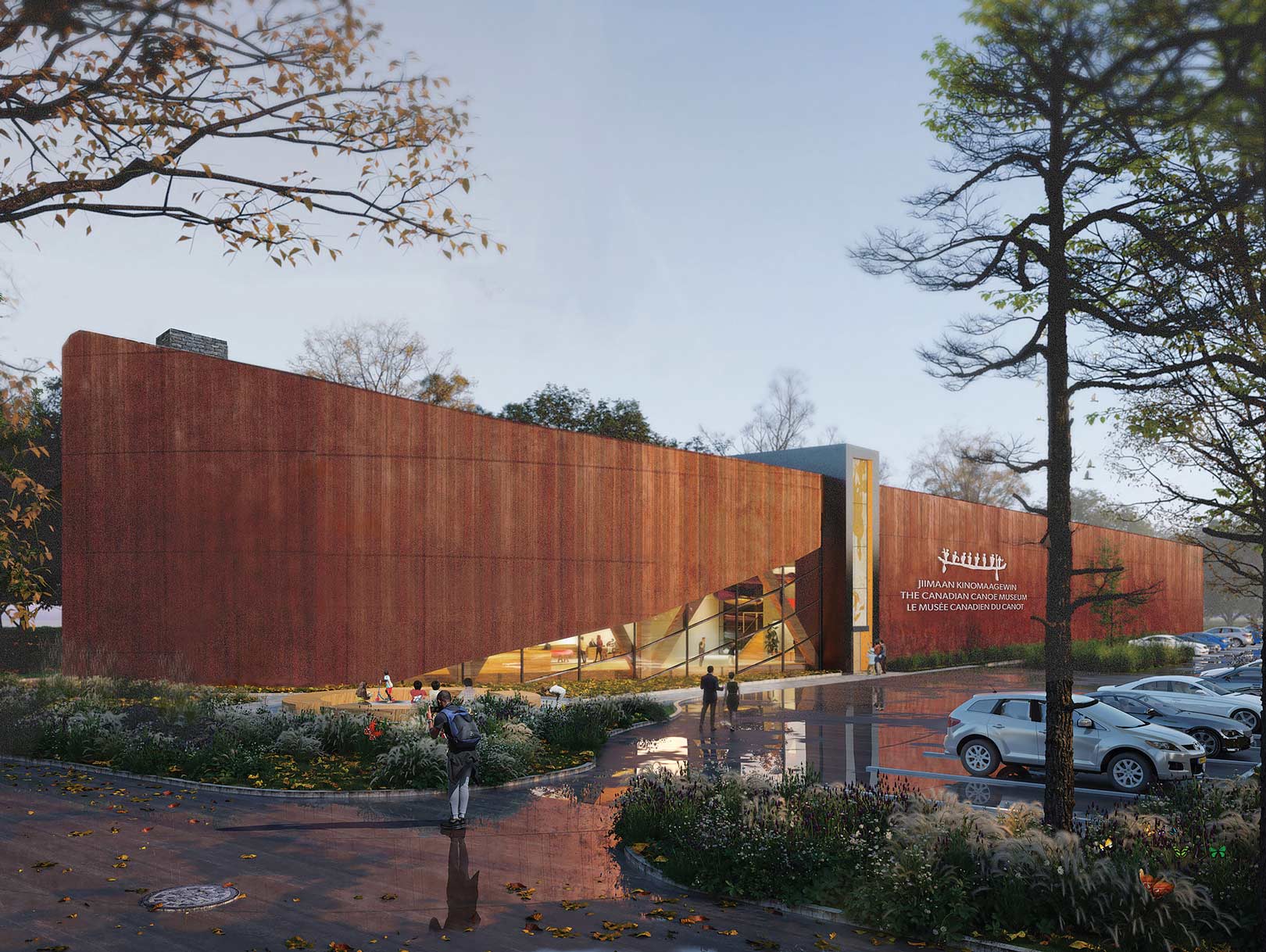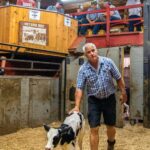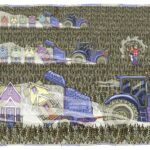
The Canadian Canoe Museum will feature a bold new design, a soaring public atrium, water access and storage for a culturally diverse collection of over 500 canoes. The Senate of Canada has recognized the museum as a cultural asset of national significance.

left to right: photograph by FusionRiver Photography; artistic renderings by Lett Architects Inc.; photograph courtesy Canadian Canoe Museum; photograph by Salina Kassam

left to right: Farley Mowat’s sailing canoe; onsite storage within The Collection Hall; examples of local canoe companies’ world-renowned craftsmanship.

In the summer of 1973, Trent University students mapped the Percy Portage; White Mud Portage, Winnipeg River, Paul Kane, National Gallery of Canada
A treasured collection explores the ingenuity, tenacity and resilience of those who have paddled the endless waterways of our vast country.
Seven years on the job and Carolyn Hyslop, the Canadian Canoe Museum’s executive director, wears her steel-toed boots, hard hat and safety vest like a second skin. It was not supposed to take this long, but put together COVID-19, supply shortfalls and a sudden change of venue, and the building is a sort of miracle. Jeremy Ward, curator, falls in step beside her and we scurry across Ashburnham Drive onto the still-raw construction site. The bones of the building are there: a great long two-storey rectangular warehouse with a curved corner. The rust-coloured cladding will soften the appearance and make it look like a stylized canoe.
Once inside, Hyslop waves an arm at the roughed-in space; this is the massive lobby. “The big fireplace will be over there and the café here. The artisan workshop is behind us.” We climb three flights of cement stairs and Ward takes over: “And this room can seat 160 for dinner.” Hyslop pulls a great sheet of heavy plastic aside. “This is the best view of the lake in all of Peterborough.” We look past the massive yellow excavator to Little Lake. “That’s where the docks for the canoes will be,” she begins, and Ward finishes her sentence, “and we will have a flotilla of some of the historic canoes out there on the water.”
Ward’s pride and joy is the ground floor storage, a huge 24-foot-high space for the five hundred canoes and kayaks not used in the exhibitions. “Everything will be on site. Everything,” he says proudly. Not many museums can say that.
This will be a state-of-the-art museum, archival storage, meeting rooms – the biggest and best canoe museum in the world. On today’s tour, the building is a jumble of metal tubes, electric cords and sheets of plywood. But Hyslop and Ward can see it – clear as day – as it will be.
When the new Canadian Canoe Museum is up and running, the projection is that out-of-town visitors will spend $5.6 million annually.
THE GENESIS
It started simply sixty-six years ago with a gift – an old dugout canoe – from one friend to another. Everyone has their obsessions: beer mugs, Barbie dolls, old postcards. For the late Kirk Wipper, a University of Toronto phys-ed professor, it was canoes. He collected canoes and displayed them until both his impromptu museum and the barn on the Asphodel Otonabee Line where he stored the extras were full to bursting. Help was needed. Bruce Hodgins and John Jennings, professors at Trent University, came up with a plan to rescue Wipper’s museum. Jennings enticed friends from Calgary – the canoe museum has always had a national reach – to get involved; Les Groombridge, the last CEO at Outboard Marine “sold” the nascent museum his company’s building for a dollar; others chimed in and Peterborough created what became the Canadian Canoe Museum at the corner of Lansdowne and Monaghan. It opened in 1997.
To Canadians there is something quintessentially Canadian about canoes. At the risk of spoiling our fantasy, the oldest canoe dates from somewhere between 8040 and 7510 BCE and was discovered in the Netherlands. Indigenous peoples the world over have been building canoes – carving, stretching skins over frames and digging out logs – for millennia. Canada’s Indigenous peoples have been particularly good at it. In fact, without the canoe, Canada would never have happened: it was how Indigenous people moved from place to place, traded, hunted and fought. And when Europeans arrived and recognized the importance of canoes, they exploited the opportunity and colonized the country, guided and transported by the Indigenous people.
WHY PETERBOROUGH?
Carolyn Hyslop pokes her head into a space on the second floor. “Look, the ladder is finished!” And delighted, she points at a grey emergency escape ladder. One more thing done.
The canoe museum was a small part of the economic shift from Peterborough, the manufacturing town – at its height in the 1950s and 1960s Peterborough boasted 54 trade unions – to a city reliant on service industries. Today, the regional hospital, university and college are big employers. In 2019 when the federal government announced a $10 million contribution to the Canadian Canoe Museum, the Peterborough MP at the time, Maryam Monsef, announced that the new facility would generate a thousand jobs and $111 million in economic activity in the construction phase. Once the new museum is up and running, the projection is that out-of-town visitors will spend $5.6 million annually. Arts and culture had saved the day in another Ontario town fifty years earlier. Stratford was transformed from a moribund manufacturing centre into a theatre town on the strength of not much more than a band of enthusiastic volunteers – plus the town’s name. The Stratford Festival now generates three thousand jobs and $140 million a year in economic activity.
Many Canadian towns and cities can lay claim to their own slice of canoe history. In the early 19th century, canots du maître, big industrial canoes full of trade goods, would arrive yearly in Thunder Bay and exchange their cargo with canoes from the west loaded to the gunwales with furs. There was a network of canoe routes connecting trading posts across the prairies and into BC. Atikokan in northwestern Ontario calls itself the Canoe Capital of Canada. What Peterborough had was both a historic and an economic claim. There was a canoe building industry in the area as early as the 1850s. Today there are over thirty canoe companies in Canada, very few near Peterborough, but until 1961 the Peterborough Canoe Company dominated the business. A number of years ago Sylvia Sutherland, then the mayor of Peterborough, was walking the Cornwall coastal trail in the UK. She was wearing her old Peterborough Canoe Company sweatshirt when a Cornishman coming down the trail stopped, smiled and pointed at the company logo on her shirt. “I’ve got one of them,” he said, “a red canoe.” “Well,” said Sutherland, “I’m the mayor of Peterborough, and I can tell you we make the best canoes in the world.” “That you do,” answered the Cornishman and walked on.
A new site was found on Little Lake, just below the lift lock, and a new design – adapted to the location – was chosen. And now, because they are fronting on the lake, visitors can canoe right up to the museum.
TURBULENT WATERS
The original museum that operated out of the old Outboard Marine factory for more than twenty years wasn’t state-of-the-art, but the exhibitions were good and brought in twenty thousand visitors a year. (The new museum is aiming to more than quadruple that number.) The old location was central, but it was nowhere near the water. Surely a canoe museum needs water.
By 2013 the decision had been made to upgrade the museum, to go big-time. The newly chosen site was adjacent to Peterborough’s historic lift lock on the Trent-Severn Waterway. The proposed design was a stunning, low-slung building that wound its way through the landscape – a real attention getter; a 90,000-square-foot building with generous exhibition and storage space.
“Look, over there.” Carolyn Hyslop glances, then points towards the first proposed site – near the old Westclox brick tower with its huge clock face. Westclox made clocks from 1922 to the mid-1980s. For seven years everything was looking good, and that’s when Peterborough’s manufacturing legacy entered the story. There had been two factories in the area, the Westclox factory and Fisher Gauge, which operated a metal die-casting plant. In June 2020, soil analysis showed industrial solvents had leached into the ground and contaminated the proposed museum site. It was unusable, and the much-heralded design had to be scrapped. Poorer but wiser, the project went back to square one. Carolyn Hyslop announced that they were carrying on.
From there, things moved ahead with remarkable speed. A new site was found on Little Lake, just below the lift lock, and a new design – adapted to the location – was chosen. Although the interior is smaller (65,000 square feet as opposed to 90,000), this site has more outdoor space that can be used for workshops; and now, because they are fronting on the lake, visitors can canoe right up to the museum. The site and design changes have likely had an impact on the budget, yet by the summer of 2023 there was still no official cost estimate. Over the years the quoted price tag has swung between $22 million and $65 million. The good news is that they have raised 95 percent of their $40 million capital fundraising goal.
RETHINKING A MUSEUM
The most fundamental change in the new museum is not the location or the building; rather it is the ethos. The Canadian Canoe Museum has always acknowledged and respected the primary relationship between Indigenous people and the canoe. Now with the confluence of the Truth and Reconciliation Commission report in 2015 and the museum’s own move, that acknowledgement has turned into something more profound. Twenty-five percent of the museum’s directors, including the immediate past president, are Indigenous; when it opens, the museum will be the first mainstream Canadian museum with signage in English, French and Anishinaabemowin, the regional Indigenous language. Indigenous people from six different communities will add more languages.
“This museum is not the place of a single narrative,” says Jeremy Ward. It’s a point he makes forcefully and frequently. As curator he will present exhibits and programs that aim to reflect a more complete view of Canada’s history.
In post-fur trade years, as manufacturing accelerated in Canada, the canoe made its way beyond Indigenous society. Whether it was a Victorian couple paddling around the lake on a Sunday afternoon or a whitewater voyage into the wilderness today, the custom has expanded to include all Canadians. Former Prime Minister Pierre Trudeau, who paddled many of Canada’s northern rivers, was exultant when he talked about canoeing. “Travel a thousand miles by train and you are a brute,” he said. “Pedal five hundred on a bicycle and you remain basically a bourgeois; paddle a hundred in a canoe and you are already a child of nature.”
Pierre Trudeau’s canoe and his fringed buckskin canoeing jacket, made for him by Mary Commanda, an Algonquin woman, are part of the museum’s collection; but when asked about the jacket, Ward’s reaction suggests that it’s unlikely to have the same pride of place as it once did. Perspectives have changed. Celebrity canoes – those once paddled by Trudeau or Farley Mowat or Gordon Lightfoot – as well as those manufactured by Rice Lake, Canadian, and Peterborough Canoes – will always be part of the collection, but they will not be front and centre.
The exhibition hall with its forest green walls and charcoal grey floor will house six permanent exhibitions and one temporary one. There will be a Gathering Circle and traditional healing practices like smudging. Ward is in regular contact with a group of Haida in BC that donated a canoe years ago; a new kayak is being finished in Iqaluit for display. There are six Indigenous communities across the country that are intimately involved in the development of the museum. For Ward, “The canoe is a way to understand the land on which we live.” Hyslop calls it “the lens through which we see our history.” Both say they have spent the “past umpteen years rethinking our approach,” grappling with thorny questions like what to do about Sir George Simpson. Simpson was the omnipotent 19th century governor of the Hudson’s Bay Company, who as good as ruled Western Canada.
One of the smaller artifacts in the collection is a mourning ring that belonged to Sir George, donated by recently retired CBC radio host Shelagh Rogers. George Simpson was her four-times-great-grandfather, but Rogers does not extol his virtues. Simpson spent much of his life in a canoe, travelling a record 8,000 kms in one season. He was also a key player in the European exploitation of First Nations people. What is the place of those like George Simpson and other settlers in the Canadian Canoe Museum? What historical markers do you put up? These are questions Hyslop and Ward are attempting to answer as the museum’s opening draws nearer.
NIGHT OF THE RED CARPET
The building is now scheduled to open this coming winter, in 2024, followed by the Grand Opening in May. When it does, Indigenous stakeholders and generous donors will fly in from across the country. There will be sentimental memories among some of first dipping a paddle and pushing off from the dock at the family cottage; others may remember how they conquered white water and a long portage; still others will smile bravely, secretly vowing to never again brave black flies, wet socks or aching arms. And a few – urbanites and immigrants – will look curiously at this strange craft that is part of Canadian iconography. For the Indigenous people in the room, the memories might well be different: the rivers and the portage paths that have been here for centuries are now part of land claims. The ancient craft practised by canoe makers everywhere, which was once all about cedar and birch bark, now has to share space with aluminum, graphite and Kevlar.
The Rice Lake Canoes and others of that era may be gone from the landscape, but the fur traders and what they took away in their day in those giant canoes are seen through a different lens today. And that is what a museum should be all about – reviewing and rethinking both our past and our present.
On that opening night the champagne glasses will clink and everyone will cheer. Carolyn Hyslop and Jeremy Ward will breathe an exhausted sigh of relief. And The Canadian Canoe Museum will take its place on the national stage.
PERCY PORTAGE
“Anyone who says they like portaging is either a liar or crazy.” – Bill Mason, Canadian naturalist
In September 1615, the French explorer Samuel de Champlain paddled down the Otonabee River. He had five hundred Huron and Algonquin warriors and French soldiers in tow. The flotilla went east through Rice Lake heading for the south side of Lake Ontario and a raid on the Haudenosaunee, the Iroquois confederacy. How he got to Lake Ontario remained a mystery for over 350 years.
At the little town of Hastings, Rice Lake narrows and becomes the Trent River, flowing southeastward to Lake Ontario. Local Indigenous people called the Trent, Sagetewedgewam – “the river hard to travel.” The great bend in the river as it flowed east from Hastings was punctuated with waterfalls and rapids and dropped 220 feet. Surely Indigenous travellers had followed the deer trails and found a way around the problem – a portage: a place to pick up the canoes and a path to carry them.
Fifty years ago, half a dozen Trent University students set out to find this lost portage. It was 1973 – the men had hair down to their shoulders and wandered through the fields bare chested; the young women climbed trees and swam in the creeks. They lived and worked in the old Hastings railway station, talked to people with deep roots in the area, listened to the old stories and walked the bush and the creeks. They also researched Champlain’s journals and dug through archives; eventually they found, mapped and published what they named the Percy Portage – a white-settler name to which they added an Indigenous symbol. The Percy Portage starts west of Hastings, goes south then veers east back to the Trent River at Percy’s Landing, six kilometres south of Campbellford. We might never know if Champlain and his entourage of 500 walked the Percy Portage, but it was considered such an important thoroughfare that two hundred years later it was the basis of the first road in the area.
Story by:
Karin Wells



